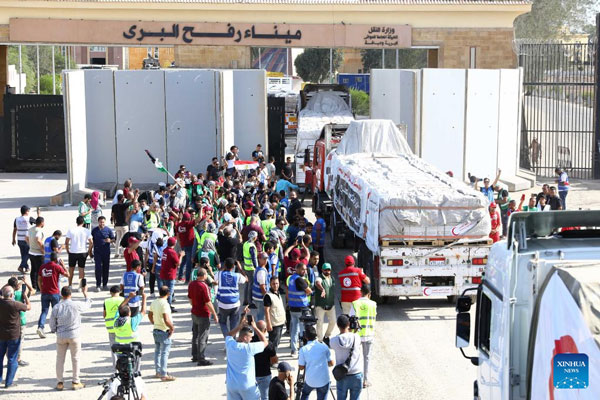
Jerusalem, Israel | Xinhua | The Palestinian Islamic Resistance Movement (Hamas) released two elderly Israeli women held hostage in Gaza on Monday, as more planes carrying humanitarian aid landed at Egypt’s al-Arish Airport in North Sinai, waiting to be sent into war-torn Gaza.
As Israel’s airstrikes on Gaza and its preparations for a possible ground invasion of the Palestinian enclave persisted, Lebanon’s Shiite military group Hezbollah and Israel clashed more along the border, raising fears of a regional escalation of the conflict.
HAMAS RELEASES HOSTAGES
Al-Qassam Brigades, the military wing of Hamas, said Monday in a statement that it has freed two more hostages for “humanitarian reasons” through “Egyptian-Qatari mediation.”
It is the second time that Hamas has released some of the hostages it took on Oct. 7 after releasing two American hostages on Friday.
An Israeli government official confirmed the release of the two Israelis, who arrived at the Rafah crossing between Gaza and Egypt, adding that an Israeli team was on its way to meet them.
Israel’s state-owned Kan TV news identified the two women as Yocheved Lifshitz, 85, and Nurit Cooper, 79. Yocheved’s husband, Oded Lifshitz, an 83-year-old journalist, was kidnapped with his wife and is still being held by Hamas.
Earlier on Monday, Palestinian sources said Hamas plans to release some foreign hostages captured in Gaza following “intense mediation efforts made by Qatar, Egypt and the United Nations.”
In a briefing to reporters, Israel Defense Forces (IDF) Spokesman Daniel Hagari said the military “has been actively involved in operational and intelligence efforts to secure the release of all the hostages,” while neither confirming nor denying reports on Hamas’ hostage-release plan.
Hagari confirmed that the number of hostages in Gaza now stands at 222, adding they include Israelis, foreign nationals, women, children, and the elderly.
MORE HUMANITARIAN AID ENTERS GAZA
The latest release of two Israelis also coincided with the delivery of the third shipment of humanitarian aid into the coastal enclave through the Rafah crossing on Monday.
The Palestinian Red Crescent confirmed that it has received the third convoy of 20 trucks carrying humanitarian aid containing food, water, medicines, and medical supplies.
Meanwhile, planes from Algeria, Kuwait, Iraq, Türkiye, the United Arab Emirates, and the World Health Organization carrying humanitarian aid for the Gaza Strip arrived at Egypt’s al-Arish Airport, which is less than 50 km from the Rafah crossing.
Turkish Health Minister Fahrettin Koca said on Monday that Türkiye sent two cargo planes to Egypt carrying medical equipment and supplies for the Gaza Strip, adding that two more aircraft would be sent with more supplies. The aircraft also carried a medical team of 20 doctors, he said on social media platform X.
ISRAEL CONTINUES AIRSTRIKES, PREPARES GROUND OFFENSIVE
Meanwhile, Israel continued its bombardment of Gaza with hundreds of air attacks on the besieged coastal enclave. According to the Gaza-based Palestinian Health Ministry, at least 436 Palestinians were killed in the last 24 hours, pushing the total death toll in Gaza to at least 5,087, which includes around 2,055 children.
Having entered its 17th day, the conflict has also killed over 1,400 people in Israel, according to official statistics.
The Israeli military reported the killing of five commanders from Hamas’ aerial array, responsible for Gaza’s air defense, in addition to “dozens” of Palestinian militants.
As the airstrikes intensified, the Israeli army prepared for a potential ground offensive, deploying tens of thousands of troops and conducting training exercises.
The IDF also carried out limited ground raids in Gaza. “During the night, there were raids by tank and infantry forces,” Hagari told reporters during a daily briefing on Monday, saying that the raids were carried out “deep” in Gaza.
The raids and air strikes “have been carried out as part of the preparations for the next stage of the war,” Hagari added.
On Sunday, Hamas said it destroyed an Israeli tank and two armored bulldozers and forced an Israeli force infiltrating east of Khan Younis in south Gaza to withdraw. The Israeli military also confirmed that a soldier was killed and three others were wounded by an anti-tank missile during a raid inside Gaza.
Meanwhile, more rockets were still launched from Gaza towards southern Israel, hitting an apartment in the southern Israeli city of Sderot. No injuries were reported, as most residents in the city had already been evacuated to central Israel.
ISRAEL-LEBANON BORDER CLASH ESCALATES
Fighting also continued along Israel’s northern border with Lebanon. Israel’s Magen David Adom rescue service reported that a ten-year-old girl and a 39-year-old man sustained minor injuries on Monday when an anti-tank missile struck the backyard of a house in Kiryat Shmona, a northern city that Israel had commenced evacuating on Friday.
The Israeli military responded by launching drone and artillery attacks on two groups of fighters who were attempting to fire anti-tank missiles from Lebanon into Israeli territory.
Lebanese army sources said a Hezbollah fighter was killed during clashes with the Israeli army on the border. This incident brought the total number of Hezbollah fighters killed within a 24-hour period to five, with four others wounded.
Hamas launched a surprise attack on Israel on Oct. 7, firing thousands of rockets and sending its militants into Israeli territory, to which Israel responded with massive airstrikes and punitive measures, including a siege on the enclave with supplies of water, electricity, fuel, and other necessities being cut off.
On Oct. 8, Hezbollah fired multiple rockets toward Israeli military sites in support of Hamas, prompting heavy artillery from the Israeli side. Since then, the Israel-Lebanon border has seen escalating tensions, increasing the odds of a broader war in the region. ■
 The Independent Uganda: You get the Truth we Pay the Price
The Independent Uganda: You get the Truth we Pay the Price



